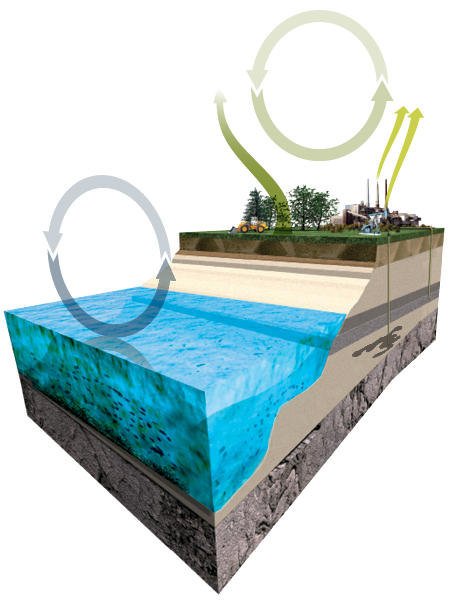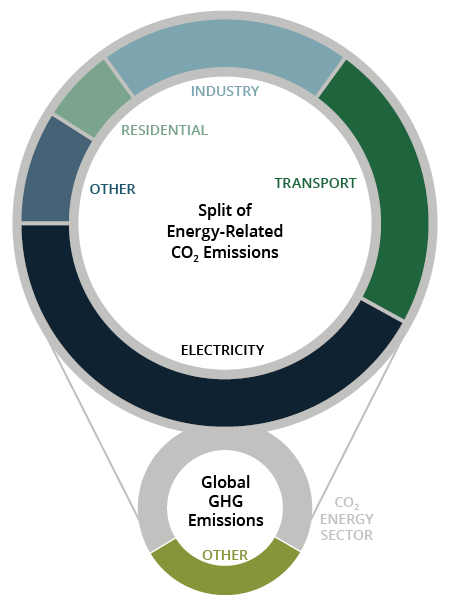Managing global carbon emissions is one of the most pressing environmental concerns of our time.
Many scientists are concerned that anthropogenic (human-made) greenhouse gases (GHG)s are affecting Earth’s climate. Although
earth-warming gases exist naturally in the atmosphere, human activities are adding more of these GHGs, including carbon dioxide.
The challenge is to address anthropogenic GHG emissions while providing access to reliable, affordable, resilient electricity
around the world.
Carbon capture, utilization, and storage (CCUS) can address this challenge, and the activities conducted through the PCOR Partnership
are playing an important role in developing CCUS technologies.
Plants take in CO2, release oxygen, and use the carbon to live and grow. Whether the plant dies, burns, or is consumed, the carbon ultimately recombines with oxygen, and CO2 is formed again. This process is a key part of the global carbon cycle: the flow of carbon in all its forms through the atmosphere, oceans, and land surface.

For most of human history, the global carbon cycle has been roughly in balance, meaning that the amount of carbon stored in the atmosphere, land, and oceans was constant. Human activities, namely, the burning of fossil fuels, deforestation, and other land use, have altered the balance of the carbon cycle, resulting in more CO2 being taken up by oceans and a 45% rise in atmospheric concentrations of CO2 since the start of the Industrial Revolution. The atmosphere now holds approximately 860 billion metric tons (or gigatonnes, GtC) of carbon, which is more carbon than contained in all of Earth’s living vegetation and roughly 80 GtC more than in 2000.
CO2 released to the atmosphere by human activity is called anthropogenic CO2, and the primary source in North America is the burning of fossil fuels for energy.

Industrial activities such as manufacturing cement, producing ethanol, refining petroleum, producing metals, and burning waste also contribute a significant amount of anthropogenic CO2. Collectively, these are referred to as large stationary CO2 point sources. Nonstationary CO2 emissions derive from activities such as using gasoline, diesel, and other fuels for transportation.

Changes in land use can also be a significant source of anthropogenic CO2. Practices like plowing, burning vegetation, and clearing forests release some of the exposed carbon in the soil and in the plants to the atmosphere as CO2.

Anthropogenic GHG emissions have grown from a few million tons per year in 1850 to nearly 40 billion tons (36 billion metric tons CO2) per year today. Global carbon emissions from fossil fuels have significantly increased the amount of GHGs from anthropogenic sources emitted to the atmosphere. Since 1970, GHG emissions have more than doubled, with emissions from fossil fuel combustion and industrial processes contributing more than 80% of the total emissions. Those emissions come from all industries; electricity generation and transportation are the biggest energy users.

Societies with access to energy sources that are affordable, reliable, and resilient provide a better quality of life for their citizens. Developing economies are adopting the latest technology to improve life for their citizens. Meeting current and future energy demand will require an all-of-the-above energy portfolio.
Carbon management is a complex issue because most anthropogenic CO2 comes from making and using energy, and energy is critical to maintaining or improving quality of life. Solutions for stabilizing and reducing carbon emissions will go beyond energy conservation and increased use of renewable energy.
CO2 has historically been thought of as plant food or as a by-product of combustion, but CO2 is now being viewed as a commodity. Based on reserves and current consumption, coal can provide electricity for hundreds of years to come. The PCOR Partnership’s efforts to deploy CCUS technologies for the world can make this a reality.